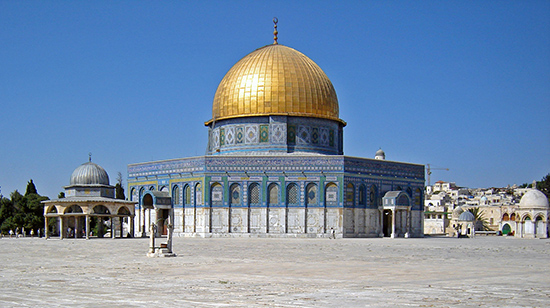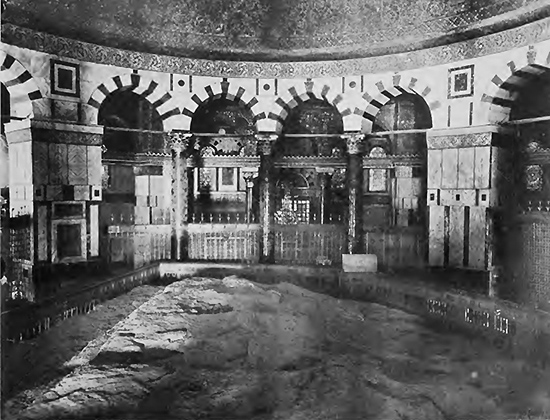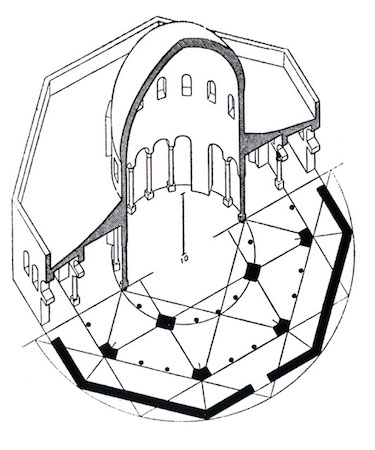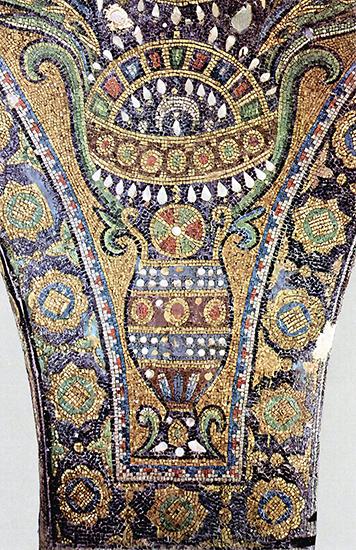The mystry and significance of Dome Rock of Al Aksha mosque in Palestine.
- Get link
- X
- Other Apps
Main content

The Dome of the Rock (Qubbat al-Sakhra), Umayyad, stone masonry, wooden roof, decorated with glazed ceramic tile, mosaics, and gilt aluminum and bronze dome, 691-2, with multiple renovations, patron the Caliph Abd al-Malik, Jerusalem (photo: Orientalist, CC BY 3.0)
The Dome of the Rock (Qubbat al-Sakhra), Umayyad, stone masonry, wooden roof, decorated with glazed ceramic tile, mosaics, and gilt aluminum and bronze dome, 691-2, with multiple renovations, patron the Caliph Abd al-Malik, Jerusalem (photo: Orientalist, CC BY 3.0)
The Dome of the Rock is a building of extraordinary beauty, solidity, elegance, and singularity of shape… Both outside and inside, the decoration is so magnificent and the workmanship so surpassing as to defy description. The greater part is covered with gold so that the eyes of one who gazes on its beauties are dazzled by its brilliance, now glowing like a mass of light, now flashing like lightning.
—Ibn Battuta (14th century travel writer)
A glorious mystery
One of the most iconic images of the Middle East is undoubtedly the Dome of the Rock shimmering in the setting sun of Jerusalem. Sitting atop the Haram al-Sharif, the highest point in old Jerusalem, the Dome of the Rock’s golden-color Dome and Turkish Faience tiles dominates the cityscape of Old Jerusalem and in the 7th century served as a testament to the power of the new faith of Islam. The Dome of the Rock is one of the earliest surviving buildings from the Islamic world. This remarkable building is not a mosque, as is commonly assumed and scholars still debate its original function and meaning.

Interior of the Dome of the Rock (photo: Robert Smythe Hitchens, public domain)
Interior of the Dome of the Rock (photo: Robert Smythe Hitchens, public domain)
Between the death of the prophet Muhammad in 632 and 691/2, when the Dome of the Rock was completed, there was intermittent warfare in Arabia and Holy Land around Jerusalem. The first Arab armies who emerged from the Arabian peninsula were focused on conquering and establishing an empire—not building.
Thus, the Dome of the Rock was one of the first Islamic buildings ever constructed. It was built between 685 and 691/2 by Abd al-Malik, probably the most important Umayyad caliph, as a religious focal point for his supporters, while he was fighting a civil war against Ibn Zubayr. When Abd al-Malik began construction on the Dome of the Rock, he did not have control of the Kaaba, the holiest shrine in Islam, which is located in Mecca.
The Dome is located on the Haram al-Sharif, an enormous open-air platform that now houses Al-Aqsa mosque, madrasas and several other religious buildings. Few places are as holy for Christians, Jews and Muslims as the Haram al-Sharif. It is the Temple Mount, the site of the Jewish second temple, which the Roman Emperor Titus destroyed in 70 C.E. while subduing the Jewish revolt; a Roman temple was later built on the site. The Temple Mount was abandoned in Late Antiquity.
The Rock in the Dome of the Rock
At the center of the Dome of the Rock sits a large rock, which is believed to be the location where Abraham was prepared to sacrifice his son Ismail (Isaac in the Judeo/Christian tradition). Today, Muslims believe that the Rock commemorates the night journey of Muhammad. One night the Angel Gabriel came to Muhammad while he slept near the Kaaba in Mecca and took him to al-Masjid al-Aqsa (the farthest mosque) in Jerusalem. From the Rock, Muhammad journeyed to heaven, where he met other prophets, such as Moses and Christ, witnessed paradise and hell and finally saw God enthroned and circumambulated by angels.

K.A.C. Creswell, Sectional axonometric view through dome, ©Creswell Archive, Ashmolean Museum, Image courtesy of Fine Arts Library, Harvard College Library
K.A.C. Creswell, Sectional axonometric view through dome, ©Creswell Archive, Ashmolean Museum, Image courtesy of Fine Arts Library, Harvard College Library
The Rock is enclosed by two ambulatories (in this case the aisles that circle the rock) and an octagonal exterior wall. The central colonnade (row of columns) was composed of four piers and twelve columns supporting a rounded drum that transitions into the two-layered dome more than 20 meters in diameter.
The colonnades are clad in marble on their lower registers, and their upper registers are adorned with exceptional mosaics. The ethereal interior atmosphere is a result of light that pours in from grilled windows located in the drum and exterior walls. Golden mosaics depicting jewels shimmer in this glittering light. Byzantine and Sassanian crowns in the midst of vegetal motifs are also visible.
The Byzantine Empire stood to the North and to the West of the new Islamic Empire until 1453, when its capital, Constantinople, fell to the Ottoman Turks. To the East, the old Sasanian Empire of Persia imploded under pressure from the Arabs, but nevertheless provided winged crown motifs that can be found in the Dome of the Rock.
Mosaics
Wall and ceiling mosaics became very popular in Late Antiquity and adorn many Byzantine churches, including San Vitale in Ravenna and Hagia Sophia in Constantinople. Thus, the use of mosaics reflects an artistic tie to the world of Late Antiquity. Late Antiquity is a period from about 300-800, when the Classical world dissolves and the Medieval period emerges.

Mosaic detail from the Dome of the Rock (public domain)
Mosaic detail from the Dome of the Rock (public domain)
The mosaics in the Dome of the Rock contain no human figures or animals. While Islam does not prohibit the use of figurative art per se, it seems that in religious buildings, this proscription was upheld. Instead, we see vegetative scrolls and motifs, as well as vessels and winged crowns, which were worn by Sasanian kings. Thus, the iconography of the Dome of the Rock also includes the other major pre-Islamic civilization of the region, the Sasanian Empire, which the Arab armies had defeated.
A reference to Burial Places
The building enclosing the Rock also seems to take its form from the imperial mausolea (the burial places) of Roman emperors, such as Augustus or Hadrian. Its circular form and Dome also reference the Church of the Holy Sepulcher. The circular Church of the Holy Sepulcher in Jerusalem was built to enclose the tomb of Christ. The Church of the Holy Sepulcher and the Dome of the Rock have domes that are almost identical in size; this suggests that the elevated position of the Dome of the Rock and the comparable size of its dome was a way that Muslims in the late 8th century proclaimed the superiority of their newly formed faith over Christians.
The Inscription
The Dome of the Rock also contains an inscription, 240 meters long, that includes some of the earliest surviving examples of verses from the Qur‘an – in an architectural context or otherwise. The bismillah (in the name of God, the merciful and compassionate), the phrase that starts each verse of the Qu’ran, and the shahada, the Islamic confession of faith, which states that there is only one God and Muhammad is his prophet, are also included in the inscription. The inscription also refers to Mary and Christ and proclaim that Christ was not divine but a prophet. Thus the inscription also proclaims some of the core values of the newly formed religion of Islam.
Below the Rock is a small chamber, whose purpose is not fully understood even to this day. For those who are fortunate enough to be able to enter the Dome of the Rock, the experience is moving, regardless of one’s faith.
Essay by Dr. Elizabeth Macaulay-Lewis
Additional resources:
Want to join the conversation?
- Do we know how the mosaics were designed? Was there a main artist who had assistants such as many other works of art? Was there a rough outline of the design somewhere or were the designs done free hand? They are beautiful nonetheless.•
- Many of the 45,000 blue and gold exterior tiles were installed under Suleiman the Magnificent in the 1500s.
- Just something I wanted to point out, our good friends Beth and Steve of Khan Academy have not been able to make a video concerning this building yet because it is only open to Muslims.•
- In the article it says:
"While Islam does not prohibit the use of figurative art per se, it seems that in religious buildings, this proscription was upheld."
Is this true? This seems contrary to what I have been taught in school and other architecture history textbooks, which say that all figurative representation (idolatry) is prohibited.•- Nope -- there are so many counterexamples. Just look up Arabic, Safavid (Muslim Persian) or Mughal (Muslim Indian) miniatures. You will find a whole treasury of figures.
Here is a 13th century Arabic manuscript depicting Socrates, of all people: http://www.gettyimages.com/detail/illustration/socrates-discussing-philosophy-with-his-disciples-arabic-stock-graphic/142451036
- "This remarkable building is not a mosque, as is commonly assumed and scholars still debate its original function and meaning."
Then immediately after we read this:
"Between the death of the prophet Muhammad in 632 and 691/2, when the Dome of the Rock was completed, there was intermittent warfare in Arabia and Holy Land around Jerusalem. The first Arab armies who emerged from the Arabian peninsula were focused on conquering and establishing an empire—not building."
Is it likely then that the Dome of the Rock was built to exemplify the power of this new religion of Islam over previous religions that considered this site holy? I have heard that this is the single most holy spot on the planet to the Jews for instance and thus by building here it serves as a strong reminder of who is in charge...
Note: I am not condemning or condoning the Dome of the Rock or any religions mentioned above, just adding a thought to the dialogue.• - Who wrote the article?
I'm trying to write a citation fyi• - who was the builder of Dome of the Rock•
- some of what you're asking may be answered in this article:
http://www.metmuseum.org/exhibitions/listings/2012/byzantium-and-islam/blog/where-in-the-world/posts/dome-of-the-rock
- how does the dome of the rock accommodate islamic beliefs and practices?•
- actually , i saw many pictures in the dome of the rock's interior and i noticed that there is another prominent art used and applied on the dome , and no one mentioned any information about it .
in the light of having the same art in Syria , I would like to to make sure that it was Damascene art or not
we call this art as Ajami art but I just need to know if it is the same for the interior of the walls and some arches including the dome itself
thanks.• - why is this space sacred to christians?•
- All of Jerusalem is sacred to Christians. The temple mount, upon which Qubbat al-Sakhra stands, is neither more nor less sacred than any of the rest of the city.
- How does physics apply to the architecture of this building? How does the octagonal shape play a role?•
- some of what you're asking may be answered in this article:
http://www.metmuseum.org/exhibitions/listings/2012/byzantium-and-islam/blog/where-in-the-world/posts/dome-of-the-rock
- Get link
- X
- Other Apps
Comments
Post a Comment